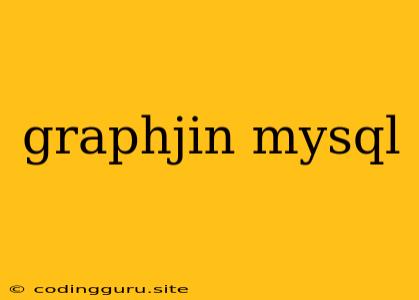GraphJin: Bridging the Gap Between GraphQL and MySQL
In the ever-evolving landscape of modern web development, GraphJin emerges as a compelling solution for developers seeking a seamless integration between GraphQL and MySQL. This powerful tool acts as a bridge, enabling the utilization of the highly expressive query language, GraphQL, with the familiar and robust MySQL database.
GraphJin simplifies the process of building APIs by leveraging the strengths of both GraphQL and MySQL. Let's explore its capabilities and understand why it is rapidly gaining traction in the developer community.
Why Choose GraphJin?
GraphJin addresses a fundamental challenge faced by developers: the need to navigate complex data structures and relational databases efficiently. By introducing GraphQL as a query layer, it allows for a more intuitive and flexible approach to data retrieval.
Here are some key reasons why developers are turning to GraphJin:
- Simplified API Development: GraphJin eliminates the need for tedious and repetitive code for defining REST APIs. Its GraphQL interface simplifies the process, reducing development time and effort.
- Data Flexibility: GraphJin allows you to query and manipulate your MySQL data using the expressive power of GraphQL. This enables you to build complex queries and retrieve exactly the data you need, without overfetching.
- Enhanced Performance: GraphJin optimizes queries for efficient data retrieval. Its internal query planner ensures that data is fetched with minimal overhead, resulting in faster response times.
- Improved Developer Experience: GraphQL's intuitive syntax and powerful introspection capabilities make it easier for developers to understand and interact with your data. This leads to a more productive and enjoyable development experience.
How Does GraphJin Work?
GraphJin acts as a middleware layer between your GraphQL client and your MySQL database. It receives GraphQL queries and translates them into the corresponding SQL statements for execution against your database.
The process can be visualized as follows:
- GraphQL Query: A GraphQL query is sent to the GraphJin server.
- Query Translation: GraphJin parses the query and translates it into a valid SQL statement.
- Database Execution: The translated SQL statement is executed against your MySQL database.
- Data Retrieval: The results from the database are retrieved and formatted into a GraphQL response.
- Response Delivery: The GraphQL response is sent back to the client.
GraphJin handles the complex task of translating between these two languages, allowing developers to focus on building their application logic.
Getting Started with GraphJin
Here's a quick guide to getting started with GraphJin:
- Installation: Install the GraphJin CLI tool using your package manager.
- Configuration: Configure your GraphJin server by specifying your MySQL connection details.
- Schema Definition: Define your GraphQL schema based on your MySQL database structure.
- Start Server: Start the GraphJin server and access your GraphQL API endpoint.
GraphJin offers detailed documentation and examples to help you get started.
Example Scenario
Imagine you have a simple MySQL database containing information about products and their categories. Using GraphJin, you can create a GraphQL schema that reflects this data structure. You can then query the database using GraphQL to retrieve information about specific products or categories.
Example GraphQL Query:
query {
products(category: "Electronics") {
id
name
price
}
}
This query would retrieve information about all products in the "Electronics" category. GraphJin would translate this query into an appropriate SQL statement and execute it against your database, returning the desired results in a GraphQL response.
Conclusion
GraphJin empowers developers with a powerful tool for building GraphQL APIs that connect to MySQL databases. By bridging the gap between these two technologies, it simplifies the process of data access and manipulation, enhancing developer productivity and enabling the creation of highly scalable and efficient applications. With its intuitive syntax, robust features, and active community support, GraphJin is a valuable addition to any developer's toolkit.
